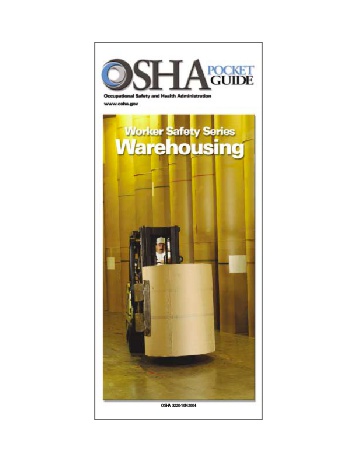
Charging Stations
Hazard:
Fires and explosion risks are possible unless proper guidelines are followed.
Solutions:
• Prohibit smoking and open flames in and around charging stations;
• Provide adequate ventilation to disperse fumes from gassing batteries;
• Ensure that fire extinguishers are available and fully charged;
• Provide proper personal protective equipment such as rubber gloves and eye and face protection;
• Properly position forklifts and apply brakes before attempting to change or charge batteries; follow required procedures when refueling gas or propane fueled forklifts;
• Provide conveyors, overhead hoists or equivalent materials handling equipment for servicing batteries;
• Provide an eyewashing and safety shower facility for employees exposed to battery acids.
Poor Ergonomics
Hazard:
Improper lifting, repetitive motion or poor design of operations can lead to musculoskeletal disorders in workers.
Solutions:
• If possible, use powered equipment instead of requiring a manual lift for heavy materials;
• Reduce lifts from shoulder height and from floor height by repositioning the shelf or bin;
• Ensure overhead lighting is adequate for the task at hand;
• Provide employees with task-oriented ergonomic training;
• Use your legs and keep your back in a natural position while lifting;
• Test the load to be lifted to estimate its weight, size and bulk, and to determine the proper lifting method;
• Get help if the load exceeds the maximum weight a person can lift safely without assistance;
• Don’t twist while carrying a load, but shift your feet and take small steps in the direction you want to turn;
• Keep floors clean and free of slip and trip hazards.
Other Hazards
Inadequate fire safety provisions, improper use of lockout procedures and failure to wear personal protective equipment also create hazards in the warehouse workplace.
Employers should have an emergency plan that describes what is expected of employees in the event of an emergency, including:
• Provisions for emergency exit locations and evacuation procedures;
• Procedures for accounting for all employees and visitors;
• Location and use of fire extinguishers and other emergency equipment.
Warehouse operations need a lockout/tagout program to prevent equipment from being accidentally energized and injuring employees. Employees required to perform these operations should be trained and all employees should have a working knowledge of the program.
Finally, management at warehouse operations needs to conduct a site hazard assessment to determine what personal protective equipment (PPE) must be worn based on the hazards present and train warehouse employees on proper PPE selection, use and maintenance


